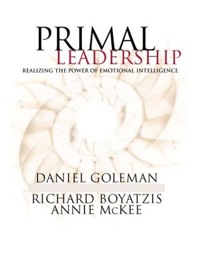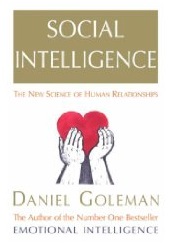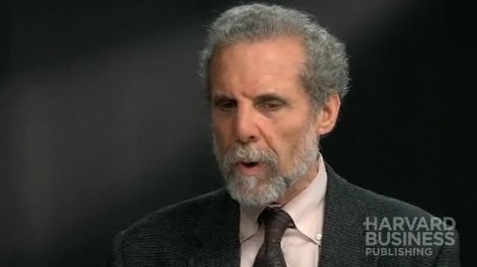Daniel Goleman on Leadership and Emotional Intelligence
Watch a video of Goleman being interviewed about emotional intelligence here.
Last week, when I mentioned to my Twitter network that I needed to do some reading on ‘Leadership’, quite a few recommended the work of Daniel Goleman. Then, when I looked at the ‘Further Reading’ section of Jo Owen’s How to Lead that I’ve just started reading, Goleman was mentioned again. How to Lead cited some contributions Goleman made to the Harvard Business Review. Thankfully, I’ve access to this electronically through being a student at the University of Durham.
What follows are my notes and thoughts on 5 articles (and a letter) by Goleman, all published in the Harvard Business Review. Each subtitle is the name of Goleman’s article, along with the year published. 🙂
What make a Leader? (1998)
 Many believe that leadership is an art rather than a science. Why? Because ‘every businessperson knows a story about a highly intelligent, highly skilled executive who was promoted into a leadership position only to fail at the job.’ Goleman believes that whilst IQ and technical skills are not irrelevant (they are ‘threshold capabilities’) but what is much more important is emotional intelligence. Indeed, Goleman asserts that his research shows that this is twice as important as a driver of outstanding performance compared to the other two factors.
Many believe that leadership is an art rather than a science. Why? Because ‘every businessperson knows a story about a highly intelligent, highly skilled executive who was promoted into a leadership position only to fail at the job.’ Goleman believes that whilst IQ and technical skills are not irrelevant (they are ‘threshold capabilities’) but what is much more important is emotional intelligence. Indeed, Goleman asserts that his research shows that this is twice as important as a driver of outstanding performance compared to the other two factors.
Goleman states that emotional intelligence is made up of the following characteristics:
- Self-Awareness – ‘the ability to recognize and understand your moods, emotions, and drives, as well as their effect on others.’
- Self -Regulation – ‘the ability to control or redirect disruptive impulses and moods’ and ‘the propensity to suspend judgment – to think before acting.’
- Motivation – ‘a passion to work for reasons that go beyond money or status’ and ‘a propensity to pursue goals with energy and persistence.’
- Empathy – ‘the ability to understand the emotional makeup of other people’ and ‘skill in treating people according to their emotional reactions.’
- Social Skill – ‘proficiency in managing relationships and building networks’ and ‘an ability to find common ground and build rapport.’
Emotional intelligence is not easy, says Goleman, but it can be learned!
Leadership That Gets Results (2000)
Goleman contends that what leaders should do is get results. Pure and simple. The question is how is this achieved? Research by the consulting firm Hay/McBer found there are six main leadership styles ‘each springing from different components of emotional intelligence.’ Goleman likens these leadership styles to golf clubs in a seasoned professional’s bag: you choose the correct club (‘style’) for each shot (‘situation’).
The six styles are:
- Coercive – demand immediate compliance.
- Authoritative – motivate people towards a vision.
- Affiliative – create emotional bonds and harmony.
- Democratic – build consensus through participation.
- Pacesetting – demand excellent and self-direction.
- Coaching – developing people for the future.
These styles impact directly on the ‘climate’ of an organization, defined as comprising the following elements:
- Flexibility – how free people are to innovate.
- Responsibility – the sense of responsibility people have to the organization.
- Standards – the standards that people set.
- Rewards – the accuracy of performance feedback.
- Clarity – how clear people are about mission and values.
- Commitment – how committed people are to a common purpose.
Of the six styles, four of them act positively towards the climate of the organization and two in a negative sense. The two that damage the climate of an organization are Coercive (‘do as I say, now!’) and Pacesetting (‘do as I do, now!’). That being said, there are times, usually during times of crises when these leadership styles can prove effective in the short-term.
Being able to switch between the six styles is a matter of Emotional Intelligence, something akin to changing habits, says Goleman. It is something that can be learned and has to be practised.
Primal Leadership (2001)
 Goleman, Boyatzis and McKee continued Goleman’s original research into emotional intelligence, coming up with the concept of leaders having an ’emotional style.’ This, they believe, sets the tone for the whole organization, that ‘the leader’s mood is quite literally contagious, spreading quickly and inexorably throughout the business.’
Goleman, Boyatzis and McKee continued Goleman’s original research into emotional intelligence, coming up with the concept of leaders having an ’emotional style.’ This, they believe, sets the tone for the whole organization, that ‘the leader’s mood is quite literally contagious, spreading quickly and inexorably throughout the business.’
The authors state that the brain’s limbic system, it’s emotional centre, is an ‘open-loop’ system. Unlike self-regulating closed-loop systems, an open loop system relies on external sources to maintain itself. ‘In other words, we rely on connections with people to determine our moods.’ That’s why we find it difficult not to smile or laugh ourselves when we hear laughter. It is this that the emotionally intelligent leader needs to tap into as good moods, it would appear from the research, transmit more quickly that bad ones! 😀
Leaders cannot simply ask those further down the hierarchy for feedback on their emotional style. Why? Job security and the personal nature of such feedback are two very good reasons. Instead, leaders need to go on journeys of self-discovery and personal reinvention that are ‘neither newfangled nor born of pop psychology.’ The authors point towards eiconsortium.org as being a useful starting point.
The journey of self-discovery and personal reinvention, contend the authors, is a five-step process of asking questions:
- Who do I want to be?
- Who am I now?
- How do I get from here to there?
- How do I make change stick?
- Who can help me?
I find these questions, if I’m honest, a little patronising. But then, after studying Philosophy at university as an undergraduate, I’m fairly self-reflective in any case. What do you think? Useful questions or not?
Never Stop Learning (2004)
 In this very short article Goleman says that leaders can survive without much ’emotional intelligence’ if everything is going well for the business. However, this is exactly the time that leaders should be building up and developing their emotional intelligence for the downturn and potential crises.
In this very short article Goleman says that leaders can survive without much ’emotional intelligence’ if everything is going well for the business. However, this is exactly the time that leaders should be building up and developing their emotional intelligence for the downturn and potential crises.
The data shows that people’s emotional intelligence tends to increase with age, but this is not to say that it is a function of, and comes with, experience. One of the most frequent criticisms of newly-promoted leaders is that they lack empathy. The problem, of course, being that they have been promoted for their intelligence and outstanding performance rather than their leadership skills.
Leaders can improve their emotional intelligence if they are given:
- Information – candid assessment of their strengths and limitations from people they can trust.
- Guidance – a specific development plan using ‘naturally occurring workplace encounters as the laboratory for learning.
- Support – someone to talk to as they practice how to handle different situations.
It’s hard to argue with the principles and ideas behind Goleman’s emotional intelligence, although I do wonder whether the inclusion of the word ‘intelligence’ is helpful… :-p
Social Intelligence and the Biology of Leadership (2008)
Research shows, says Goleman and Boyatzis, that certain things leaders do affects their brain chemistry and that of their followers. In fact,
researchers have found that the leader-follower dynamic is not a case of two (or more) independent brains reacting consciously or unconsciously to each other. Rather, the individual minds become, in a sense, fused into a single system.
Great leaders, say the authors, are at the opposite end of the ‘neural continuum’ than those with autism or Asperger’s, social disorders ‘characterized by underdevelopment in the areas of the brain associated with social interactions.’
 The authors therefore introduce the concept of social intelligence, ‘a set of interpersonal competencies built on specific neural circuits (and related endocrine systems) that inspire others to be effective.’ Pointing to recent research in neuroscience on ‘mirror neurons’ which act as ‘neural wifi’. When we detect other people’s (emotions through their actions), our mirror neurons reproduce these emotions, leading to a feeling of shared experience.
The authors therefore introduce the concept of social intelligence, ‘a set of interpersonal competencies built on specific neural circuits (and related endocrine systems) that inspire others to be effective.’ Pointing to recent research in neuroscience on ‘mirror neurons’ which act as ‘neural wifi’. When we detect other people’s (emotions through their actions), our mirror neurons reproduce these emotions, leading to a feeling of shared experience.
So, Goleman and Boyatzis say, the ‘old carrot-and-stick’ approach for encouraging people to perform better, doesn’t work. Smiles, laughter, nods and positive reinforcement are much more conducive to improving performance. Followers of effective leaders experience rapport with them – what the authors call ‘resonance’.
‘The only way to develop your social circuitry effectively,’ say Goleman and Boyatzis, ‘is to undertake the hard work of changing your behavior.’ Linking back to Primal Leadership, the authors believe this is a process of building a personal vision for change and gathering feedback. It is especially important to undergo this when things are going well, as during times of stress as ‘soaring cortisol levels and an added hard kick of adrenaline can paralyze the mind’s critical abilities.’ Leaders fall back into old habits during these times – all the more reason to become more self-reflective.
A Reply to Ken Otter (2009)
Finally, in a letter to the Harvard Business Review, Ken Otter gave his thoughts on an article by Goleman and Boyatzis. The authors took the time to reply to this, in which they made the following point – important and especially relevant to me about online communication:
Andrea Zambarda’s query about whether the brain’s social circuitry operates as well during communication by phone and videoconference as it does during face-to-face interactions raises an issue that is becoming increasingly important to companies. The brain’s circuitry picks up crucial social signals during communication, receiving the most during face-to-face interactions, somewhat fewer during videoconferences, and fewer still during phone calls. When communication is via e-mail or text alone, however, no emotional signals whatsoever are received, resulting in the greatest likelihood of missed cues.
…and that’s why I almost always put a smiley in my tweets, text messages and blog posts! 🙂


![Reblog this post [with Zemanta]](http://img.zemanta.com/reblog_e.png?x-id=5d0a62cd-ef85-4fa0-b2e1-5dc99abcb7bd)



